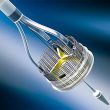A new edition of ProEducar José Gabay course started at Pacará Room, at Buenos AIres Hilton Hotel. In a friendly, warm atmosphere, the Fellowship Director, Dr. Leandro Lasave, set opened the course together with SOLACI-CACI 2017 President, Dr. Ruben Piraino, and CACI vice President, Dr Anibal Damonte. Dr. Lasave thanked both SOLACI and CACI authorities...
Statin Pre-Treatment for the Prevention of Peri-Procedural Events in Carotid Artery Stenting
Recent randomized studies have shown that the rates of combined peri-procedural events for carotid artery stenting and carotid endarterectomy are similar. While the final numbers are similar, the actual events are different: more infarction events for endarterectomy and more stroke (particularly minor stroke) events for carotid artery stenting. The reduction of these rates of stroke has been the aim of...
Risk of spinal cord infarction in aortic aneurysm repair
Spinal Cord infarction represents roughly 1% of all strokes and can lead to severe impairment, like paraplegia or quadriplegia. Aortic endovascular and surgical repair of aortic aneurysms or dissections could result in spinal cord infarction, because the vascular supply of the spinal cord largely originates directly from the aorta. Spinal cord ischemia (SCI) rate in patients undergoing aortic repair varies depending on the...
How can we classify aortic stenosis in patients who underwent TAVR?
Courtesy of Dr. Carlos Fava. Aortic stenosis can present different hemodynamic patterns, such as low flow and low gradient with reduced or preserved ventricular function. However, evidence on the evolution of different hemodynamic patterns after transcatheter aortic valve replacement (TAVR) is limited. This study consisted in a retrospective analysis of 368 patients who underwent TAVR. The population was divided in...
Protection Systems Reduce Stroke and Mortality in Carotid Artery Stenting
So far, the main controlled randomized studies have almost exclusively been aimed at comparing the efficacy and safety of carotid artery stenting vs. endarterectomy. Almost all of them have left at operator discretion the choice of the devices to be used during the procedure, which is why there is few direct information to help us...
In which patients should we attempt chronic total occlusion rechanneling?
Although chronic total occlusion (CTO) is a common finding, there is little consensus as to when such lesions should be treated routinely with angioplasty. Benefits of successful rechanneling include relief of symptoms, resolution of ischemia, improvement in ventricular function, and avoidance of myocardial revascularization surgery. Unsuccessful rechanneling is common and may be associated with several adverse events,...
Lotus Valve performance related to pacemaker implantation in patients after TAVR
Courtesy of Dr. Agustín Vecchia. Paravalvular leak was once considered the greatest disadvantage of TAVR when compared to conventional surgery. Nowadays, new devices and more-experienced operators have managed to “control” this phenomenon, keeping related statistics within acceptable ranges. Repositionable-valve Lotus may probably offer the most effective solution for this event; however, it is associated with high rates of...
Glycemic control and risk of repeat revascularization
The association between glycemic control after coronary angioplasty and outcomes of the latter is controversial in many studies. We have come to think that the risk lies in suffering from diabetes, as if it was an unmodifiable factor. We have also come to believe that glycemic control can impact microvascular complications while it cannot do...
MitraClip: Should We Intervene Earlier?
Courtesy of Dr. Carlos Fava. Repairing the mitral valve with Mitraclip has become an alternative for high risk or inoperable symptomatic patients, but its long term evolution has only been tested by the EVEREST II, which had not taken into account 5 year mortality outcomes. Therefore, to better study its evolution, we need to carry out different randomized studies...
Reciprocity agreement between ESVB and SOLACI
On behalf of all who make part of SOLACI, we are thrilled to announce a reciprocity and mutual collaboration agreement with the European Symposium of Vascular Biomaterials (ESVB). This association will allow us to create new relationships with important European professionals in the field and, in time, enhance and strengthen the presence of SOLACI worldwide. This year,...









